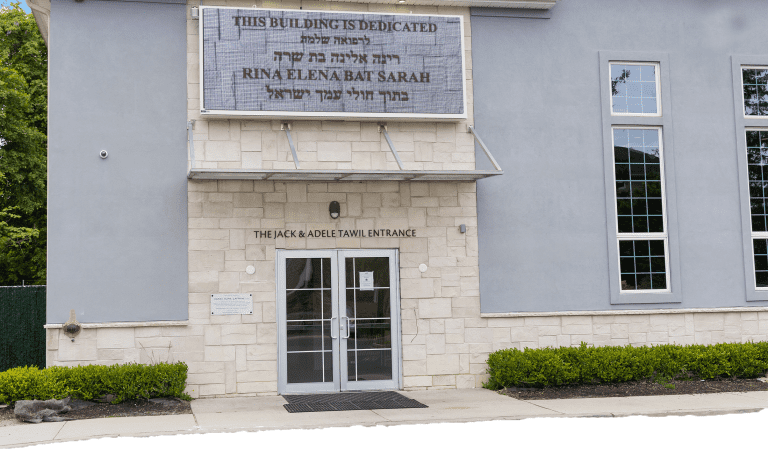There are so many things to consider when talking about this crucially important topic. One of them is that before we look at our kids’ use of technology, we have to first look at ourselves and the example we are setting for them.
Of course, this is easier said than done. We don’t want our kids to spend as much time on screens as we do, but what can we possibly expect when they see our faces in our phones day in, and day out?
Recently, my daughters’ school invited the parents to a talk by Rabbi Joey Haber titled, “Tech Talk.” His speech really got me thinking, and I’m sure every parent in the room took something away from it, too. The school urged us to put something into practice already that same night while we were inspired, as we otherwise may never get around to it. They even brought a rabbi from TAG to filter phones right there and then.
Filters aren’t a solution for people like me who use phones for business, but there was something else that I was able to do. The rabbi informed us that iPhones have a setting called “Screen Time” which can log and – if you set it to – limit the amount of time you spend on certain apps. My main goal is to give my kids my full attention when they are around, and to avoid conveying the message that screen addiction is just fine once you become an adult… And so I decided to put in place a number of realistic boundaries. I set limits on my use of certain non-essential apps to three hours. Every weekday from 4-7pm – from around the time my kids get home until around the time they go to sleep – my apps go from their normal vibrant colors to a darker version. If I click on one of them (which is basically habit at this point), I get a reminder that these are screen-limit hours, and I am asked if I wish to exit the app, or ignore the screen limit and go ahead with the app, either for a certain amount of time or for the rest of the day. This feature has been very helpful for me and, by extension, for my children, reminding me to be present with them. From 4-7pm, my phone no longer rings with useless notifications sucking me back in when I should be attentive to my kids.
I asked community members via my Instagram what they do to protect their kids from an abundance of screen time. Here’s what they had to say.
Allison H. Bailey
We’ve put several rules in place to try to safeguard our children from the technology we have in our homes. First, we have parental controls and passwords on the TV and on our phones. When they’re looking at our phones, they’re monitored; we’re looking along with them, or we make sure they’re watching something educational. We recently decided to get a Kindle instead of iPads so the kids watch less TV and play more educational games, and so that we can place parental controls in place and monitor their use. My husband is getting to the point of wanting to eliminate all TV so that the kids don’t turn into mindless zombies.
Two weeks later:
The Kindle with a password and parental controls is really working out beautifully. They haven’t watched TV during the week at all, and it’s really functioning nicely. We stopped allowing TV watching on weekdays because our son found out the password and began watching whenever he wanted. During the week, they play educational games on their Kindle, but it’s only games that we download, and the Kindle itself has a password that only me and my husband know, so it’s not a free-for-all.
Freda B. Sasson
I’m so happy you’re having a discussion this topic. For years, I’ve been searching for a filter besides TAG, and I haven’t been able to find one that I like where the parent can have control. My problem with the community filters is they don’t trust the parents to have control; if I want to buy pajamas online, I have to call a random rabbi somewhere to unlock the device. For this reason, I have no filters. On the other hand, I think kids need filters, but when I called the SAFE parenting division to see what they suggest (they’ve had some lectures over the past couple years about children and technology, so I thought they might have some advice), they recommended not installing filters, saying that the kids will just get around them, Instead, I was told, we need to teach kids what to avoid.
I think both sides of the spectrum are not working well for the regular mainstream community family. I’ve posted many times asking if anyone can recommend a filter, and all the responses shared what I am already aware of, none of which I find to be useful, such as programs which just send the parents annoying reports about the sites that their children visit. Our community definitely needs a more parent-friendly internet filter solution!
Mollie Elbaz Briskman
For years now, I’ve been trying to figure out how to strike the right balance when it comes to technology. I believe that screen-time should be limited to the least amount possible, but I also feel that technology can be such a useful educational tool if it is utilized properly. For example, I allow my kids to watch old shows with extensive vocabulary lessons, and simple-life situations made fun. And, considering the world we live in today, I find it disadvantageous to keep children away from technology entirely. Moreover, my home is considered a “smart home,” so tech is everywhere you turn. This has actually enhanced my son’s knowledge in some pretty fantastic ways. We have Echo devices around the home, all which have been set up to have child filters and passcodes on them, so my son is able to get general and clean information on his own. He has thus learned to navigate through the internet in the safest way available.
I can view everything my son does from the history, which allows me to give him the space to make decisions on his own, while giving me peace of mind. Of course, this is not a perfect solution by any means; it’s still trial-and-error. I’ve had many pounds of chocolate chips “accidentally” ordered to my house…but we’ve tried to create learning experiences through it all.
I will admit that it can be overwhelming trying to find the right balance, especially when you catch them late at night learning how to make chocolate brownies from Martha Stewart… but at least I know what to do with all these chocolate chips now!
Ida Levy
From the day my kids got their phones, we always charge them overnight in a public space like the kitchen. I don’t think kids – especially teenagers – should have their phones in their rooms at night, because the phones make it so tempting to stay up all hours of the night. And, it’s much healthier to put your phone away 30-60 minutes before you go to sleep, as this helps you get better quality sleep.
Also, late at night is when kids get into the most trouble on the internet, whether it’s social media, bullying, or inappropriate activity. Giving them privacy throughout the night is just not a good idea. Furthermore, phones are very addictive, so it’s a good idea to set a “power down time,” whenever that may be, when they walk away from it. Another reason is that friends text at all hours and kids have major FOMO (fear of missing out), so they rarely turn off alerts. Overnight alerts disrupt their sleep.
I try not to let it bother me when my kids tell me that none of their friends have these guidelines. All it means is that I’m being a better mother.
Margo Cohen
When it comes to technology and my kids, I can tell you this: I don’t have a computer for them to use, I don’t own any tablets, and I don’t have a TV. Instead of wasting away in front of screens, my kids are involved in creative activities such as arts-and-crafts and outdoor play. They climb trees, go on the swings, play in the basement, and call their friends using a landline… They get creative for entertainment like the good ‘ol days. When they see me on my phone scrolling through Instagram, they all huddle around me because its action, just like TV, so I purposely stopped scrolling on my phone when I’m with them.
In my opinion, technology is the worst thing for kids. Of course, it is helpful in certain areas, but when you’re buying a small screen to shove directly into your child’s face so you don’t have to be bothered with entertaining them, it has repercussions. Kids these days don’t know how to socialize; they don’t have a social life like we used to. They don’t know how to properly communicate because of all this technology that they are bombarded with already at a young age when their brains are developing and they are learning about the world. I see such a difference in behavior between my kids who have minimal screen time and other kids who have access to screens daily.
When we visit family members who have a TV, I allow my kids to watch along with their relatives as long as it’s a show I deem harmless. If it’s something I don’t approve of, I ask that it be changed, but I don’t demand they shut the TV because we are there. Sometimes the kids ask to go to my mom’s house, and I know that they’re asking because they want to watch TV. I don’t blame them – screens are very addictive. I have a computer for my work and they don’t have access to it; I don’t give them the password. In the past, I would show them an Uncle Moishy video on my computer, and when it was over, when I tried shutting the computer, they insisted “One more! One more!” and then they went crazy, not knowing how to entertain themselves. So I stopped even doing that. When they want music, I put Spotify on my phone. They can listen; they don’t need to watch.
This morning, my kids were building towers with magna tiles, and it was incredible. I remember when I was young, we just watched TV until the bus came. I got the TV out of the house early on so my kids never grew up with easy access to screens, whereas my friend’s kids would watch TV and act crazy. One day, she decided enough was enough, and she dismounted her TV screen and put books in its stead. She reported that the adjustment was very difficult for the first couple of weeks, but as time went on, they not only learned to entertain themselves, but they also became generally a lot calmer and better behaved. It was very difficult at first, because they were used to completely tuning out and watching TV, and so their brains weren’t used to relaxing with books and coloring. I don’t think this is the generation we want for the future leaders of Judaism, so every Jewish home needs to have this conversation – what small steps we can take to protect our kids from technology that so desperately wants to enter our homes and influence our lives.
Marlene H. Levy
I truly believe that the most important way to protect our kids against technology is to have a rule that children tell you their passwords for all devices. This way you can spot check what they are doing whenever you want. Another rule is no phones or laptops in their room after bedtime. I don’t believe in TVs in their room, either, or gaming devices, of course. Movies and shows must be watched in public areas of the house so we see or hear what they are watching. Nowadays, phones and laptops turn into TV and movie screens, and there’s no end to technology. It’s here with us, so we parents need to monitor it as best we can.
*****
This topic is very personal – solutions that work for one family are not necessarily the right solutions for others. My primary objective in doing this article is to encourage parents to have the conversation, to consider what we can be doing better in this area. Don’t accept the status quo for our children; they deserve better.
I believe that although there are countless detrimental effects that we already know about, the full extent of the damage wrought by technology and social media are yet to be seen. I don’t make this comment with the intention of fear mongering, and I won’t list the frightening statistics about depression and other effects of excessive use of technology. Deep down, we know what is and isn’t right for our children. The most important thing is to acknowledge that technology is a force to be reckoned with, and to make a game plan that works for you.
Until next time, Frieda
Check Frieda out on Instagram @friedaschwekyphoto.











